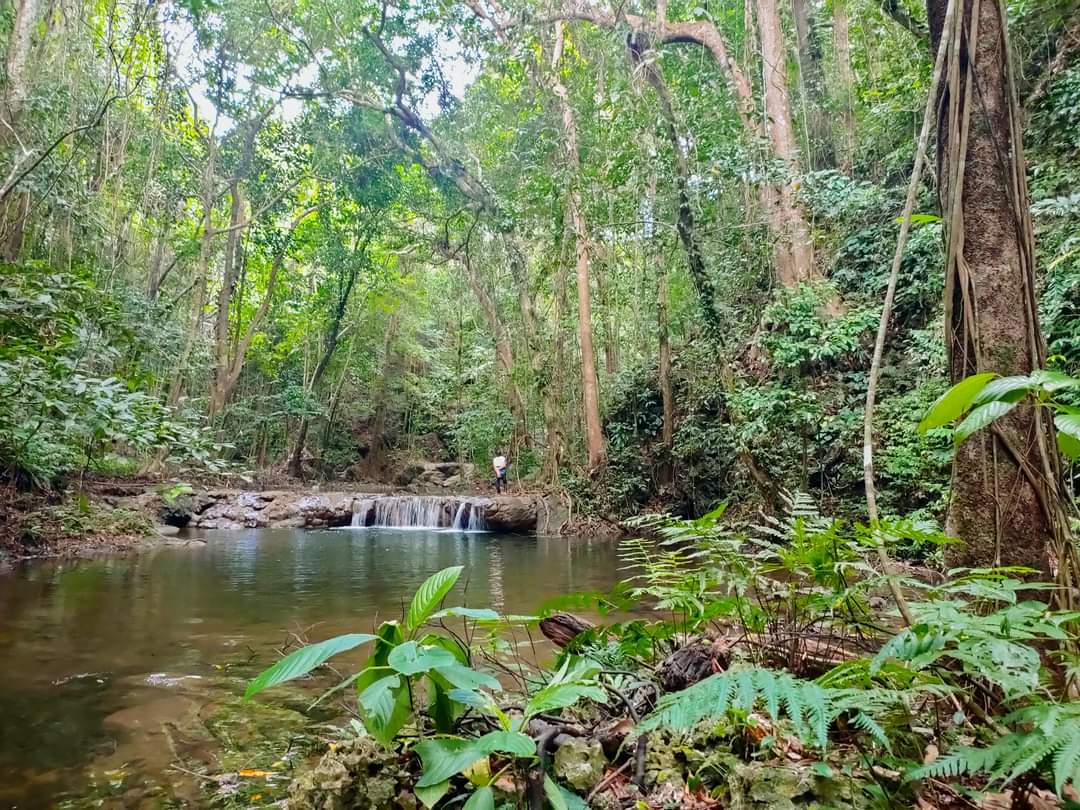𝐎𝐍𝐄 𝐎𝐅 𝐓𝐇𝐄 𝐅𝐋𝐀𝐆𝐒𝐇𝐈𝐏 𝐖𝐀𝐓𝐄𝐑𝐅𝐀𝐋𝐋𝐒 𝐎𝐅 𝐋𝐀𝐒𝐀𝐌
📌Sicalao, Lasam, Cagayan| 010724| Cultural Mapping of Natural Heritage
VIDEO:
https://fb.watch/pwRmzeQWPp/?mibextid=Nif5oz
 |
| Kama Falls, among the most beautiful waterfalls in Lasam |
DESCRIPTION
The Kama Falls is a 3-leveled waterfall located northwest of Sicalao, Lasam, Cagayan, still part of the northeastern hemline of the Cordillera mountain range.
The lowest tier, inclining at 45 degrees angle is about 15 meters in length measuring from its base up to its ledge leading the the second tier. It has the widest water flow among all the tiers.
 |
| The lowest level of Kama Falls (first tier) |
The slightly shorter second level rises about 12 meters from the base with an inclination of almost 90 degrees angle. This cascade is the most majestic, the most voluminous and has the most powerful flow rate among all the levels of Kama Falls.
 |
| The middle level of Kama Falls (second tier) |
The third tier is a relatively short cascade sloping at about 30 degrees angle and is 3 meters long. Though small, it is the only tier that has a plunge pool with a maximum depth of 3 feet.
 |
| The relatively small topmost level of Kama Falls (third tier) |
The surrounding areas of the cascades are dominated by bamboos (𝑺𝒄𝒉𝒊𝒛𝒐𝒔𝒕𝒂𝒄𝒉𝒚𝒖𝒎 𝒔𝒑.), giant ferns and variety of vines. "Bilagot" plants (𝑺𝒄𝒉𝒊𝒔𝒎𝒂𝒕𝒐𝒈𝒍𝒐𝒕𝒕𝒊𝒔 𝒔𝒑.) can also be seen abundantly thriving well around and on the waterways.
 |
| Bilagot plants thriving around and along the waterways |
The Kama Falls is located 1.5 kilometers south of Nangaribuan Falls. Unlike the latter which directly feeds the Sicalao River, the Kama Falls emanates from a stream that travels 1 kilometer before joining its main stem Sicalao River.
Like all other waterfalls of Sicalao, Kama Falls is nearer to the municipality of Flora, Apayao than it is to Centro, Lasam. It is considered as the tallest waterfall and arguably the most beautiful body of water in the municipality of Lasam.
STORIES
There are no clear, convincing and widely accepted accounts as to why the waterfall is called "Kama Falls".
But according to Mr. Bubot Lebantino, a Sicalao farmer and a part-time local guide, the ledges or tops of the first and second tier of waterfall appear flat and horizontally straight as viewed from a certain angle resembling a double-decker bed and thus, the term "Kama".
 |
| The top ledge of Kama Falls resembling a bed or "kama" |
"Kama" is both the Filipino and Iluko translation for "bed".
Related Stories:
https://m.facebook.com/story.php?story_fbid=2760148460904583&id=100007283687906&mibextid=Nif5oz
https://www.facebook.com/media/set/?set=a.1805204703065635&type=3&mibextid=Nif5oz
https://m.facebook.com/story.php?story_fbid=2842183596034402&id=100007283687906&mibextid=Nif5oz
SIGNIFICANCE
As the grandest of the "Trio Falls" flagship of Sicalao, Kama Falls represents nature's raw power and beauty. It is the driving force behind the construction of Sicalao Highest Point Access Road funded and implemented in partnership with the Department of Tourism (DOT) thru the Convergence and Special Support Program. The waterfalls would be easily more accessible through this road and would spark economic growth in Lasam, especially in Sicalao through rural enterprise productivity and tourism.
 |
| The spectacular views of Sicalao draw the interest of nature enthusiasts, travelers, writers and photographers |
The aesthetic charm of Kama Falls provides something alluring and glamorous that photographers, travelers, hikers and nature lovers always wanted to see, thereby a contributing factor for the local community economic growth stated above.
Related:
https://m.facebook.com/story.php?story_fbid=641161381145292&id=100057543074032&mibextid=Nif5oz
More so, with its formidable, uninterrupted flow rate, it could be harnessed through scientific and geomorphological studies for potential energy source.
CONSERVATION
The local-based DENRO or the Deputized Environment and Natural Resources Officers of Sicalao (Bantay Gubat) are expected to help in law enforcement, conduct information drive and mitigate destructive activities pertaining to the environment.
 |
| Bamboo groves of Sicalao threaten by traditional slash and burn practice or "kaingin" |
The barangay officials and the police are also vital parts for the conservation and protection of our tropical rainforests and are expected not to tolerate or condone any environmental abuses.
CONSTRAINTS AND THREATS
Illegal logging is still a multi decade-old threat to the rainforests of Sicalao and other parts of Lasam that is still in existence as of this day. Such remnants of the scrupulous activities can be clearly seen not far and along the established trails.
Reference:
https://m.facebook.com/photo.php?fbid=648609990400431&id=100057543074032&set=a.318285370099563&mibextid=Nif5oz
Satellite images of the vicinity suggest patches on the mountains cleared of trees for planting corn, banana and other crops. Forests along the rivers are declining and the recession has been observed to its greatest extent in the last 7 years.
 |
| Illegal logging in Sicalao destroys natural habitats and biodiversity |
Due to lack of records and monitoring in the barangay level, visitors without any environmental knowledge and concern get an easy access into the waterfalls and thus, in huge part could be contributing factors for the litters seen along the way and around the vicinity.
INFORMANTS
Bubot Lebantino, Sicalao Farmer
Norly "Bulldog" Lebantino, Sicalao Guide
Mark James Rodillas Galamay Sicalao Guide, Content Creator
#EndlessFunCagayan #IntoTheWildSeries #Cagayan #CagayanProvince #ChasingWaterfalls #ExploreLasam #RaceToHundredFalls #Tworismo #SicalaoLasam #YourIslandsAndValleyOfFUN #tworismosalambak #YourIslandsAndValleyOfFUN #VisitCagayanPH














































































